Golden glow since 1964: the 35th Lux Sarasaviya Film Awards light up! Silver Screen Salutes
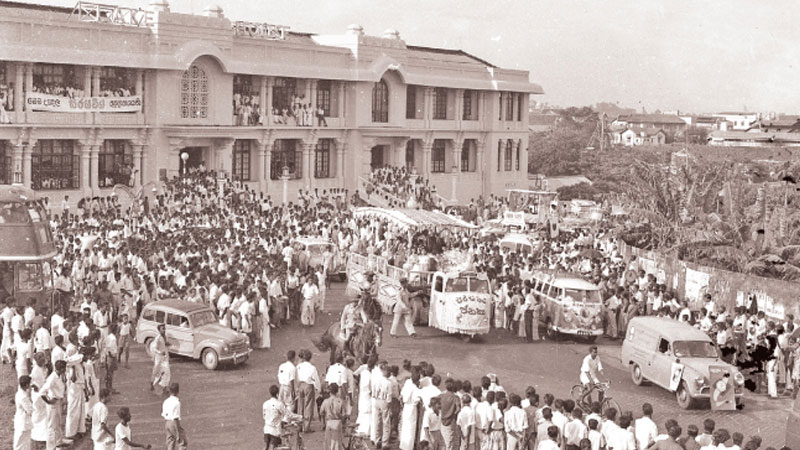
The Sarasaviya Awards ceremony is recognised as an illustrious event in Sri Lankan cinema. The 35th Lux Sarasaviya Film Awards is set to take place at the BMICH on March 28 (today) at 6 pm. The festival and grandeur may last only a few days, though the groundwork commences nearly three months prior. Years ago, movie aficionados expressed their preferences by filling out coupons published in newspapers such as Sarasaviya (and Janatha, the now defunct evening Sinhala newspaper) to vote for their favourite films.
Prior to the festival, a series of pre-activities take centre stage in the organisational process. Key responsibilities included selecting a panel of judges and establishing rules and criteria for film evaluation used in assessing each award category.
Moreover, organisers are tasked with arranging screenings for the panel of judges to view each film, ensuring that they have ample opportunity to evaluate the entries thoroughly. Equally important was the preservation of confidentiality surrounding the final judgments and conclusions, ensuring the integrity and fairness of the evaluation process.
Inaugural festival
The inaugural Sarasaviya Film Festival took place on May 9, 1964, at the Ashoka Cinema Hall in Colombo. Sarasaviya Editor Vimalasiri Perera presided over the event. The ceremony witnessed the attendance of the famous Hindi actress Meena Kumari. This event marked a significant milestone in Sri Lankan cinema, particularly after 17 years following the emergence of creative indigenous films such as Podi Putha, Rekhava, Sandesaya, Ranmutuduva, Kurulu Bedda, Sikuru Taruva, and Gamperaliya on the silver screen. Before this period, most films screened in Sri Lanka were of Indian origin.
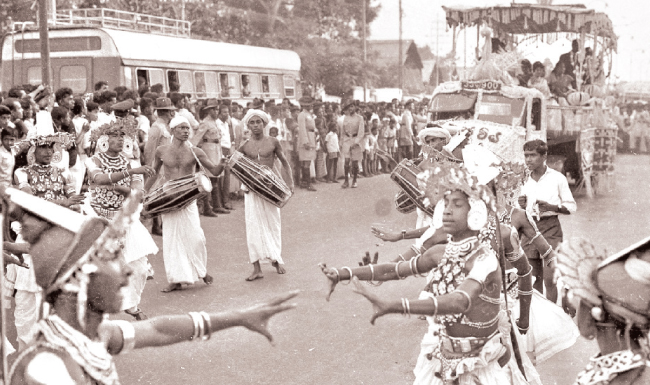
Welcoming the cinematic luminaries aboard the vehicle vessel in 1965.Welcoming the cinematic luminaries aboard the vehicle vessel in 1965.
The 1964 festival was a pivotal moment for the industry. The inaugural ceremony stood out by encompassing all Sinhala cinema works exhibited between 1960 and 1963, recognising and celebrating the achievements of local filmmakers during those formative years. Accolades were bestowed upon the Best Film, Best Director, Best Screenplay, Best Actor, and Best Actress.
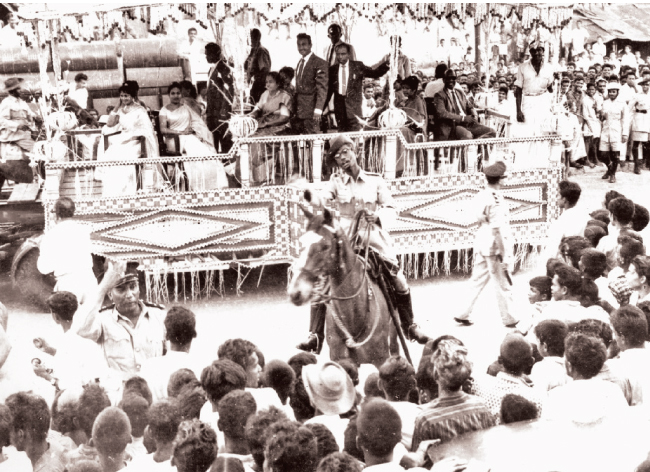
Gamperaliya Producer Anton Wickramasinghe won the Best Film award. Dr. Lester James Peiris won the Best Director Award. Punya Hindeniya was awarded the Best Actress for her role in Gamperaliya. The Best Screenplay Award went to Reggie Siriwardena. DR Nanayakkara was recognised as the Best Actor for his compelling performance in Sikuru Taruva, another award-winning film.
Police providing security for the star-studded vehicle vessel in 1965.Police providing security for the star-studded vehicle vessel in 1965.
The Sarasaviya Awards ceremony commences with a traditional Saraswathi Puja dance, a respectful homage to the Goddess Saraswathi. Accompanied by the melodious Saraswati Abhinandana song, Chandraratne Manawasinghe’s devotional verses are rendered in the soul-stirring tones of Amaradeva. As the ethereal music fills the air, the dancers who hold a lamp in their hands captivate the audience with their mesmerising presence, creating an enchanting atmosphere that sets the tone for the august evening. Notably, Chandraratne Manawasinghe clinched the Best Song award at this very festival.
Second festival
The second Sarasaviya Awards ceremony was held in 1965 under the patronage of Ceylonese Governor-General William Gopallawa.
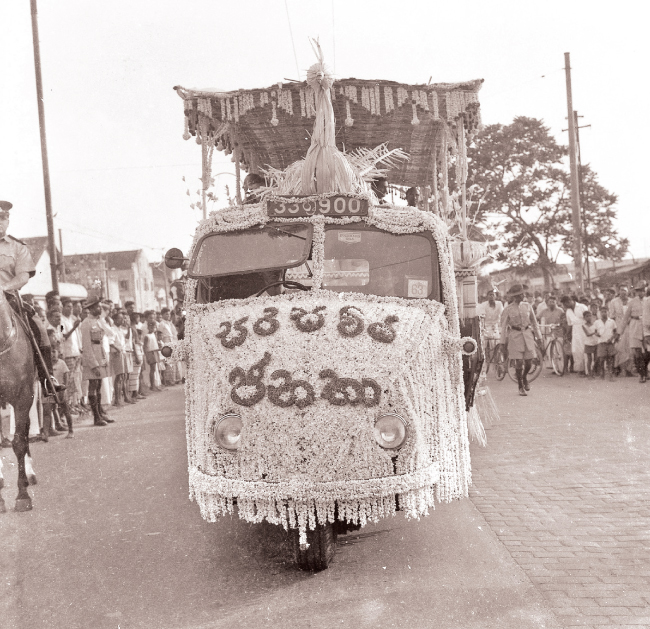
The Second Sarasaviya Awards saw a unique and extravagant entrance for the actors and actresses, who were transported in specially designed vehicular vessel. Percy Jayamanna’s article published in the Sarasaviya paper described that the vehicular vessel was adorned with intricately arranged rope and flowers. The vessel left the Lake House building and reached its destination following a two-hour picturesque cruise. The fans eagerly awaited the moment when the actors and actresses would disembark from their celestial voyage, holding their breath in anticipation.
Vehicle vessel transporting the film stars in 1965.Vehicle vessel transporting the film stars in 1965.
A notable highlight of this event was the decision to establish a connection between the Sarasaviya Film Festival and India’s much-celebrated Filmfare Awards. This move attracted Hindi film enthusiasts to the Sarasaviya Awards. To enhance this linkage, popular actor-actress couple Nutan and Sunil Dutt, along with actress Jabeen Jalil, were invited to the Sarasaviya Awards. Filmfare Magazine Editor Karanjia was also in attendance.
At this festival, Saravita won nine out of the twelve Sarasaviya awards. Mahagama Sekara won his first Sarasaviya award for the song Me Sinhala Apage Ratai.
Third festival
The third Sarasaviya festival was notably marked by the jury’s decision not to award the Best Actress accolade. In an unconventional move, Joe Abeywickrama stood alone in the photos taken that day, adhering to the tradition that prevented the publication of photos featuring the Best Actor and Actress facing each other at the Sarasaviya event that year.
The 1966 Sarasaviya Awards ceremony introduced two new additions. A friendly cricket match and a cultural show followed the festival. Indian actors and actresses took part in the match. Nutan led one team, while Ananda Jayaratne, who was celebrated for his roles in early films, including his portrayal of a Sinhalese leader opposing the Portuguese army in Sandeshaya, captained the other team. Jayaratne, with his striking appearance and captivating performances, attracted significant popularity during that era.
Cinema periodicals
Established in 1952, the ‘Cinema’ newspaper holds the distinction of being Sri Lanka’s first cinema publication, thanks to the pioneering efforts of Robert Jayawardene. Following suit, Sarasaviya Newspaper emerged in 1963 from the offices of Associated Newspaper of Ceylon Ltd, situated within the Lake House building. This marked the birth of the 46th cinema newspaper in the country, named Sarasaviya, by poet and screenwriter PKD Seneviratne. Venerable Bambarande Siri Sivali Thera guided the auspicious inauguration of Sarasaviya.
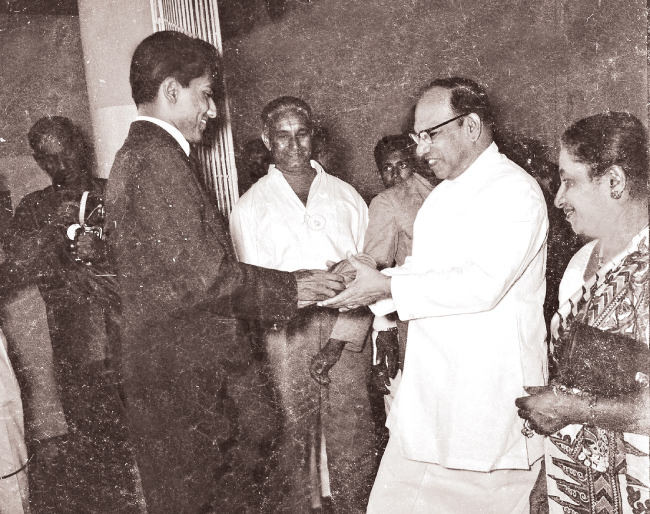
Welcoming Ceylon’s Governor-General, William Gopallawa, to the second Sarasaviya Award Festival in 1965.Welcoming Ceylon’s Governor-General, William Gopallawa, to the second Sarasaviya Award Festival in 1965.
With the establishment of the Sarasaviya newspaper came the introduction of the Sarasaviya Awards ceremony in 1964, led by Ranjit Wijewardene. In the last six decades, a total of 115 cinema newspapers were established in different formats. However, 114 of them have ceased operations, leaving the Sarasaviya newspaper as the solitary advocate for the advancement of art, standing steadfastly amidst the industry’s changing landscape.
In its 60th year, the Sarasaviya newspaper and its awards ceremony celebrate significant milestones. Despite encountering challenges that led to missed opportunities in the past, this year signifies the 35th awards night for the ceremony. Drawing inspiration from renowned events like the Hollywood Oscars and the esteemed Filmfare Awards, the Sarasaviya awards ceremony stands out as the premier accolade event in the nation, distinguished for its adherence to high standards and transparency, thus setting a notable precedent for all other awards ceremonies across the country.
D R Nanayakkara receiving the Best Actor Award in 1964.D R Nanayakkara receiving the Best Actor Award in 1964.
Sculptor Tissa Ranasinghe moulded the Sarasaviya Award. His remarkable contribution adds to the prestige and reverence associated with the Sarasaviya Awards.
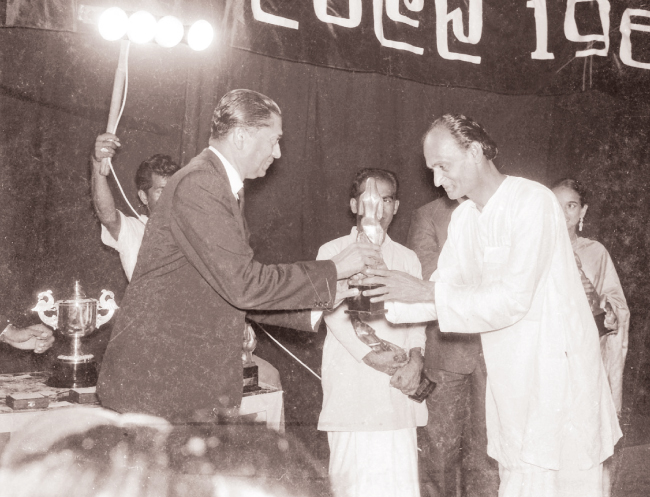
A dedicated jury decides the award. This approach ensures that artistic and technical excellence are duly recognised and honoured.
This year’s Sarasaviya Awards ceremony holds a special significance with the inclusion of the prestigious Ranathisara Award. Presented for 2019 and 2020, this award honours two esteemed senior artistes for their invaluable contributions to the cinema industry over several decades. Starting this year, the award has been renamed the Dr. Lester James Peries Memorial Ranathisara Award.
The ceremony also bestows the Ranapala Bodhinagoda Memorial Cinema Literature Award separately for 2019 and 2020. This award is a tribute to senior artistes who have made significant contributions in writing, journalism, film criticism, and other related areas.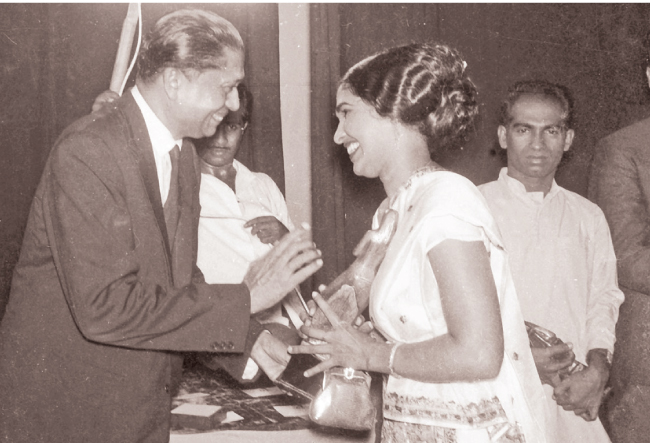
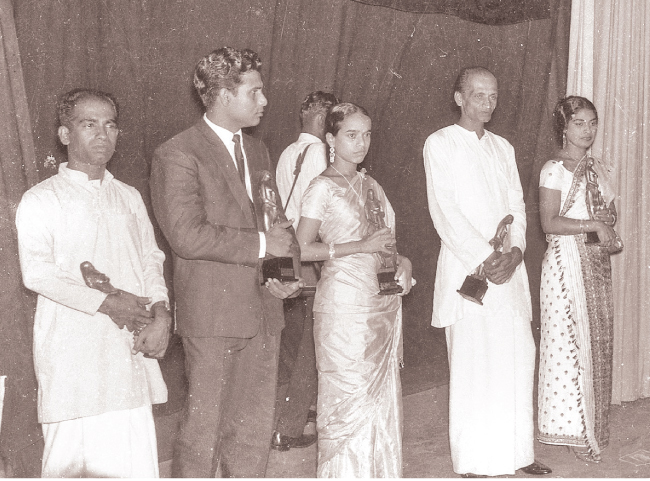
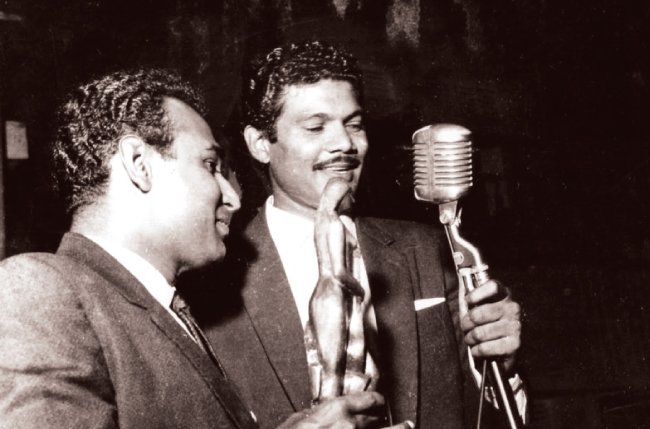
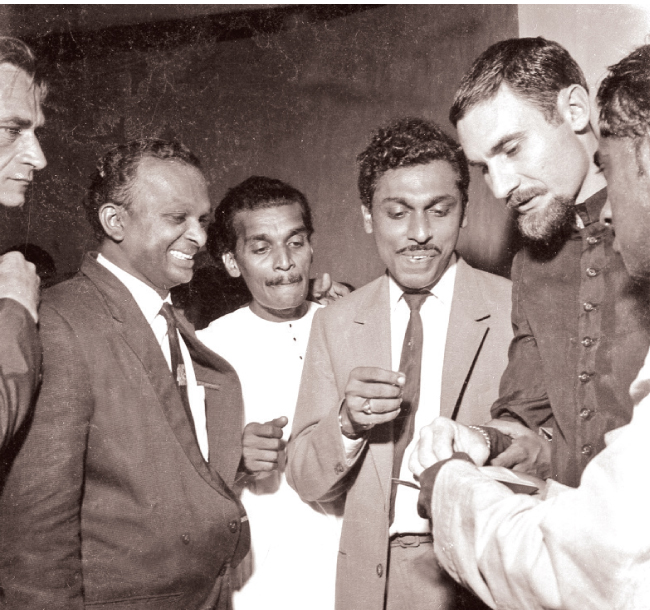
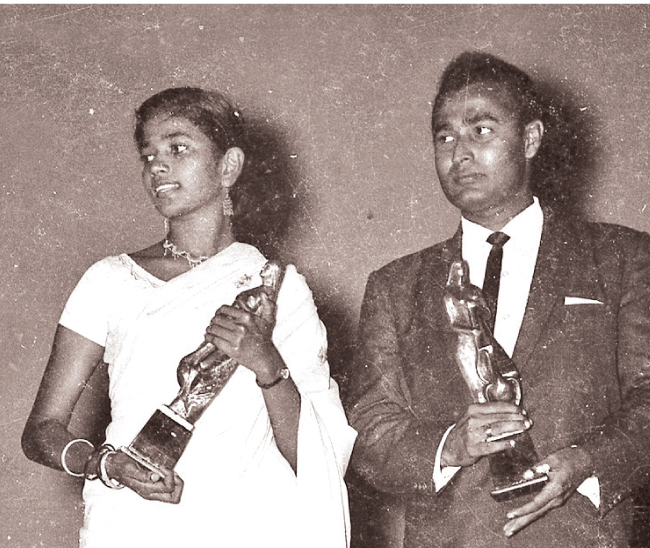
This year’s awards include:
*Blockbuster Film – 2019/2020
*Rising Star Award – 2019
* Rising Star Award – 2020
* Audience’s Favourite Actress/Actor – 2019/2020 (Selected via SMS voting)
* Outstanding Cinematography – 2019
* Outstanding Cinematography – 2020
* Excellence in Music – 2019/2020 (Best Female Singer, Best Singer, Best Lyricist, Best Music Director)
* Sound Engineering Excellence – 2019/2020
* Ranapala Bodhinagoda Memorial Literary Award – 2019/2020
* Dr. Lester James Peries Memorial Ranathisara Award – 2019/2020
* Outstanding Makeup Artistry – 2019/2020
* Outstanding Art Direction – 2019/2020
* Outstanding Editing – 2019/2020
* Outstanding Screenplay – 2019/2020
* Best Supporting Actress – 2019/2020
*Best Supporting Actor – 2019/2020
*Leading Actress – 2019/2020
*Leading Actor – 2019/2020
* Best Director – 2019/2020
*Best Picture – 2019/2020
A total of 42 films have been considered for this year’s award ceremony, comprising 30 films screened from January 1 to December 31, 2019, and 12 films screened from January 1 to December 31, 2020. Awards will be presented separately for 2019 and 2020, with popular actor and actress awards being bestowed for both years.
2019 Filmography (30)
Ginnen Upan Seethala, Sangili, Thala, Nati Bari Tarzan, Dekala Purudu Kenek, Asandimitta, Sulanga Apa Regena Yavi, Sama Kumaru Kathawa, Sansaraye Dadakkaraya, Katha Karana Heena, Weli Pavuru, Iskoleta Mang Ava, Tiththa Eththa, Subha Theraniya, Face to Face, Sikuru Yogaya, President Super Star, Jaya Sri Amatitatuma, Husma, Manaya, Rasha, Vijayaba Kollaya, You Turn, Partiban, Gori, Eka Rene Kurullo, Reload, Saki, Ula Leni, Vishama Baga.
2020 Filmography (12)
Panshu, Miss Jenis, Tsunami, The Newspaper, Roulade Panchi, Evilena Suluyi, Susti, Ithalya, Seda Mavata, Seluna, Suparna, Horn.
Sarasaviya Best Films Chronology
1964 Gamperaliya
1965 Gatavaryo
1966 Saravita
1967 Sanasuma Kothanada
1968 Sat Samudura
1969 Golu Hadawata
1970 Binaramali
1980 Hadaya
1981 Ganga Addara
1982 Sagarayak Mada
1983 Mahagedara
1984 Dadayama
1985 Maya
1986 Suddilage Kathava
1987 Maldeniya Simiyon
1988 Viragaya
1989 Sagara Jalaya Madi Heduwa Oba Handa
1990 Siri Madura
1991 Palama Yata
1992 Keli Madala
1993 Kula Geya
1994 Guru Gedara
1995 Nomiyena Minisun
1996 Loku Duwa
1997 Bawa Duka
2001 Purahada Kaluvara
2002 Sudu Sewanali
2003 Sakman Maluwa
2004 Mille Soya
2005 Ira Madiyama
2006 Udagunyamaya
2007 Agantukaya
2008 Machan
2015 Maharaja Gamunu
2016 Motor Bicycle
2017 Visi Ata

